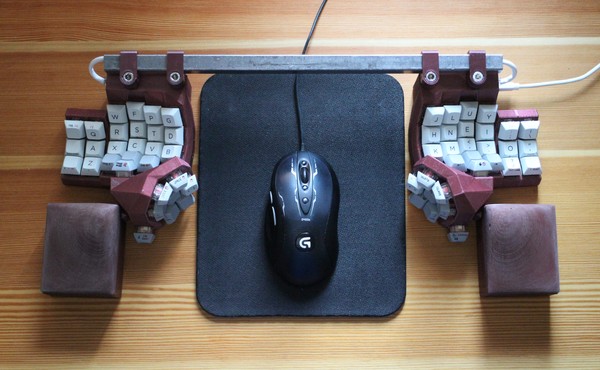3D models for an accessory to the DMOTE keyboard: Plastic parts holding a simple “back beam”, typically just an unthreaded hollow metal rod about half an inch wide. Such a beam, sold separately by your local hardware store, stabilizes the split keyboard and carries the wire that connects its two halves electronically.
DMOTE Beam is just an example project. You may not need a back beam of any kind. Feel free to accessorize however you like, if at all.
Use lein run with command-line arguments to generate files of OpenSCAD code
under output/scad and, optionally, STL files for slicing and 3D printing.
Your renders go into the output/stl folder. Some samples are included with
the project, though they are not produced from the latest source code.
The clip is used with the rear-housing feature on the DMOTE. On one side it
holds the beam, and on the other side, it’s got a hole for a threaded fastener
that closes the clip around the beam and simultaneously connects it to the
keyboard case through a nut you can put inside the rear housing. This way, you
can run a connecting wire all the way through a beam, which is appropriate if
you’ve got sockets for the wire on the far sides of the case.
You would typically print four copies of the clip, possibly in pairs with different lengths, for each keyboard you build.
The bundled sample was made for a 15 mm square-profile beam with M6 socket-cap fasteners. It was used for the master build of DMOTE version 0.2.0.
The anchor and funicular models are not intended for use with a rear housing. Instead, they’re for a back plate, an alternative feature of the DMOTE. Another point of contrast with clips is that anchors and funiculars work best when your wire sockets face each other. Each anchor connects directly to a back plate on one half of the keyboard while a pair of funiculars hang between the halves, carrying a wire or a secondary beam that contains a wire.
An anchor does not tighten around the beam the way a clip does. The idea is to run a threaded rod all the way through and put a lock nut on the outsides. In this configuration, the main beam does not enter the anchors, nor even the funiculars; it’s cut into three parts and merely maintains horizontal spacing while the rod inside provides more stability.
The bundled samples were made for an 8 mm round-profile beam with an M6 threaded rod inside and M6 countersunk screws going into the case. They were used for the master build of DMOTE version 0.1.0.
Copyright © 2018–2019 Viktor Eikman
This software is distributed under the Eclipse Public License (EPL) v2.0 or any later version thereof. This software may also be made available under the GNU General Public License (GPL), v3.0 or any later version thereof, as a secondary license hereby granted under the terms of the EPL.

